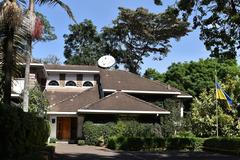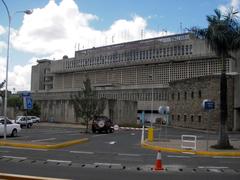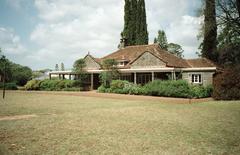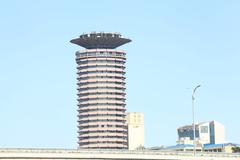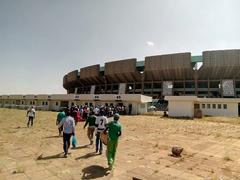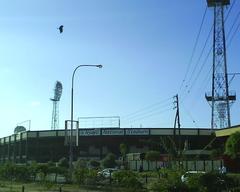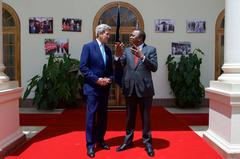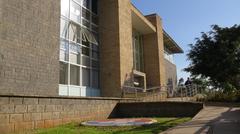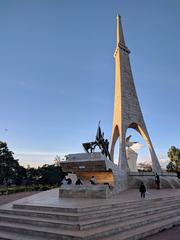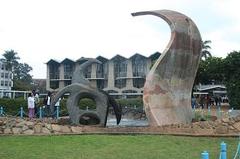Nairobi Safari Walk: Visiting Hours, Tickets, and Nearby Attractions in Nairobi, Kenya
Date: 14/06/2025
Introduction: History and Cultural Significance
Nairobi Safari Walk, located just 7 kilometers from Nairobi’s vibrant city center and adjacent to the entrance of Nairobi National Park, offers a unique wildlife experience that blends urban convenience with Kenya’s natural heritage. Established by the Kenya Wildlife Service (KWS), the Safari Walk was designed to foster accessible wildlife education for Nairobi’s growing urban population. The facility simulates a traditional safari within a controlled and sustainable setting, allowing visitors to explore three of Kenya’s principal ecosystems: savannah, wetland, and forest. Along the 1.5-kilometer elevated wooden boardwalk, guests observe rare and endangered species such as white rhinos, bongos, albino zebras, and pygmy hippos in naturalistic enclosures.
As a vital hub for conservation education, Nairobi Safari Walk features interactive exhibits, interpretive signage, and targeted programs for families, schools, and tourists. Its position at the threshold of Nairobi National Park enables seamless combination of immersive boardwalk walks and classic game drives. Nearby attractions like the Daphne Sheldrick Elephant Orphanage and the Giraffe Centre further enrich visitors’ understanding of Kenya’s conservation landscape (Trodly; Kenya Wildlife Service; Enclose Africa Safaris).
Table of Contents
- Origins and Conceptualization
- Development and Design
- Educational and Conservation Mission
- Integration with Nairobi National Park and Nearby Attractions
- Key Enhancements and Milestones
- Visitor Information
- Main Features and Legacy
- Frequently Asked Questions (FAQ)
- Visuals and Media Resources
- Conclusion and Call to Action
- References
Origins and Conceptualization
Nairobi Safari Walk was created to address the need for accessible wildlife education in Nairobi’s rapidly urbanizing environment. KWS envisioned a space where city residents and school groups could experience Kenya’s biodiversity without venturing far from the city center. As a living showcase of the country’s ecosystems, it serves as both a primer for traditional safaris and a stand-alone conservation destination (Trodly; Enclose Africa Safaris).
Development and Design
Construction of the Safari Walk began in the late 1990s, with a focus on sustainability and authenticity. The facility’s design incorporates elevated wooden boardwalks through three simulated habitats—savannah, wetland, and forest—crafted with natural materials and traditional African elements. This thoughtful architecture ensures minimal environmental impact while allowing close animal observation (Uyaphi; Trodly).
Educational and Conservation Mission
The Safari Walk is not just a recreational venue; it is a dynamic center for conservation education. Information panels and interactive exhibits along the route provide insights into animal biology, endangered species, and ecosystem functions. Regular programs for schools and families make it a go-to destination for educational field trips, while rare and threatened species—such as the white rhino and bongo antelope—highlight Kenya’s urgent conservation priorities (Uyaphi; Trodly).
Integration with Nairobi National Park and Nearby Attractions
Situated at the entrance of Nairobi National Park, the Safari Walk serves as a natural gateway to one of Africa’s most remarkable wildlife reserves. Its location allows visitors to pair the Safari Walk with a classic game drive, creating a comprehensive day of wildlife exploration. Additional attractions nearby include the Nairobi Animal Orphanage, Daphne Sheldrick Elephant Orphanage, and Giraffe Centre—each contributing to the region’s robust eco-tourism and conservation education scene (Enclose Africa Safaris; Trodly).
Key Enhancements and Milestones
Over the years, Nairobi Safari Walk has introduced several improvements to enhance the visitor experience and expand its educational reach:
- New Animal Exhibits: Focused on endangered and rare species, enriching the collection for both local and international audiences.
- Habitat Zones: Thematic zones for savannah, wetland, and forest offer targeted programming and authentic habitat simulation.
- Interactive Features: Facilities like the Children’s Museum and Hippos Pool create engaging learning spaces for all ages (Enclose Africa Safaris).
- Accessibility: The boardwalk and amenities are designed to accommodate wheelchair users and visitors with varied mobility (Trodly).
Visitor Information
Visiting Hours
- Open daily: 9:00 AM – 6:00 PM (last entry at 5:30 PM)
- For the best wildlife viewing, visit during daylight hours.
Ticket Prices
- Residents: Approx. KES 430 (adults), KES 215 (children)
- Non-Residents: USD 43 (adults), USD 22 (children)
- Children under five: Free
- Payment: Cashless only—card or M-PESA. Bring valid ID for verification (Twende Sasa; Kenya Peaks).
Getting There & Accessibility
- Location: Adjacent to Nairobi National Park entrance, off Lang’ata Road, ~7 km from city center.
- Transport: Accessible by car, taxi, or public transport (matatus 15, 125, or 126).
- Parking: Available on-site.
- Accessibility: Wheelchair-friendly boardwalks, accessible restrooms, and assistance on request.
Travel Tips
- Wear: Comfortable shoes, sun protection.
- Bring: Water (no food allowed), binoculars, camera, rain jacket during rainy seasons.
- Best times: Early morning or late afternoon for cooler temperatures and active wildlife.
Main Features and Legacy
- Elevated Boardwalk: A 1.5 km route through simulated wetland, savannah, and forest habitats.
- Diverse Wildlife: See white rhinos, albino zebras, bongos, pygmy hippos, lions, leopards, giraffes, and more.
- Birdlife: Over 400 species, including seasonal migrants—a haven for birders.
- Children’s Museum: Interactive space tailored for young conservationists.
- Ivory Burning Site Monument: Nearby landmark commemorating Kenya’s anti-poaching efforts (Uyaphi).
- Educational Signage: Panels on flora, fauna, and conservation issues line the boardwalk.
Frequently Asked Questions (FAQ)
Q: What are the Nairobi Safari Walk visiting hours?
A: Open daily from 9:00 AM to 6:00 PM (last entry 5:30 PM).
Q: How much are Nairobi Safari Walk tickets?
A: Residents: KES 430 (adults), KES 215 (children); Non-residents: USD 43 (adults), USD 22 (children).
Q: Can I buy tickets online?
A: Payments are cashless at the gate via card or M-PESA. Check the KWS website for updates.
Q: Is the Safari Walk wheelchair accessible?
A: Yes, the boardwalk is designed for wheelchair users, with accessible facilities.
Q: Are guided tours available?
A: Guided tours can be arranged by prior booking with Kenya Wildlife Service.
Q: What should I bring?
A: Water, sun protection, comfortable shoes, binoculars, camera (no food allowed inside).
Q: What are nearby attractions?
A: Nairobi National Park, Nairobi Animal Orphanage, Daphne Sheldrick Elephant Orphanage, Giraffe Centre, and the Ivory Burning Site Monument.
Visuals and Media Resources
- Explore Kenya Wildlife Service Flickr page for images of the Safari Walk.
- Virtual tours and interactive maps are available on the official KWS website.
Conclusion and Call to Action
Nairobi Safari Walk stands as a beacon of conservation, education, and accessible eco-tourism in the heart of Nairobi. Its immersive design, inclusive facilities, and educational mission make it a top destination for families, tourists, and wildlife enthusiasts. By visiting, you directly support Kenya’s conservation efforts and help nurture a new generation of environmental stewards.
Plan your visit today by checking current hours and ticket options on the Kenya Wildlife Service website. Download the Audiala app for guided tours, visitor tips, and real-time updates.
